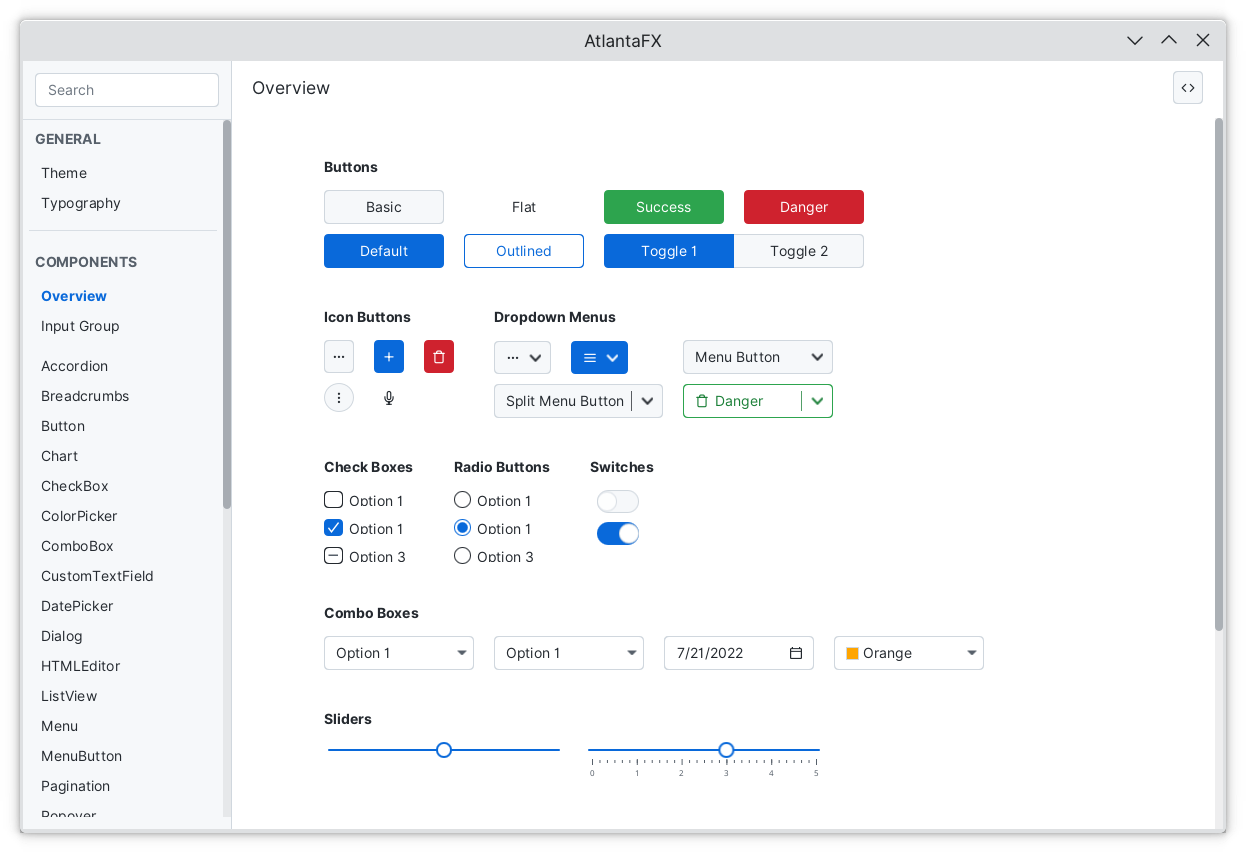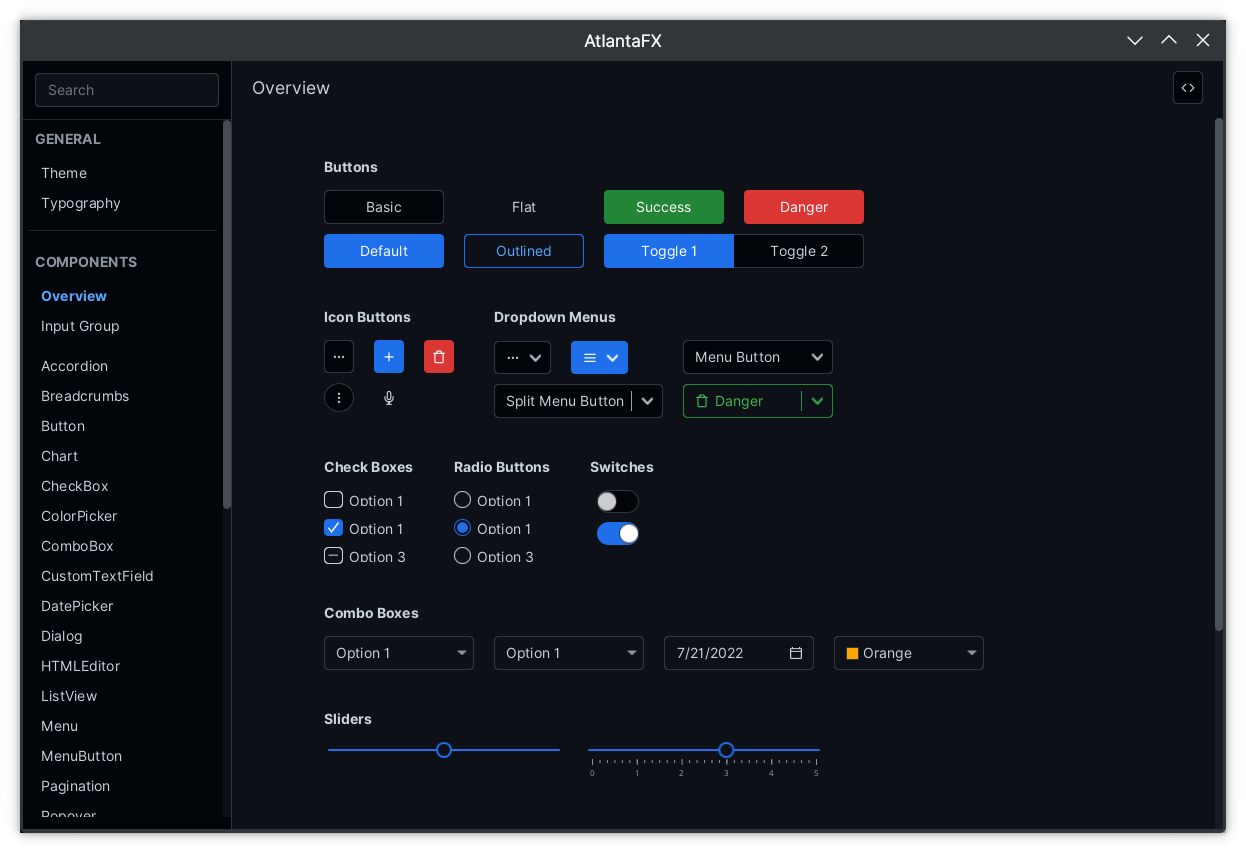Use Maven wrapper around Dart SASS binary instead of downloading and installing NodeJS / NPM locally. This also eliminates dependency from Grunt and its modules. |
||
|---|---|---|
| .github | ||
| .mvn/wrapper | ||
| .screenshots | ||
| base | ||
| sampler | ||
| styles | ||
| .gitattributes | ||
| .gitignore | ||
| CHANGELOG.md | ||
| LICENSE | ||
| mvnw | ||
| mvnw.cmd | ||
| pom.xml | ||
| README.md | ||
AtlantaFX
JavaFX CSS theme collection plus additional controls. It's inspired by FlatLaf and the variety of Web component frameworks.
Installing
Requirements: JavaFX 17+ (because of data-url support).
For now, project is in early development stage. You should add OSSRH snapshot repository to use it.
<repository>
<id>ossrh.snapshots</id>
<name>OSSRH snapshots</name>
<url>https://s01.oss.sonatype.org/content/repositories/snapshots/</url>
<releases>
<enabled>false</enabled>
</releases>
<snapshots>
<enabled>true</enabled>
</snapshots>
</repository>
<dependency>
<groupId>io.github.mkpaz</groupId>
<artifactId>atlantafx-base</artifactId>
<version>0.1.0-SNAPSHOT</version>
</dependency>
Set CSS theme:
Application.setUserAgentStylesheet(new PrimerLight().getUserAgentStylesheet());
// or
Application.setUserAgentStylesheet(new PrimerDark().getUserAgentStylesheet());
Build
You can either use CLI or create run configuration in your favorite IDE.
# compile SASS into styles/dist directory,
# you can stop here and use compiled CSS files in your app just like that
mvn install -pl styles
# compile additional controls, it will also copy previously compiled CSS files
# into the module classpath
mvn install -pl base
After building module dependencies you can play with the sampler application. If you just want the demo, run:
mvn javafx:run -pl sampler
If you want to use hot reload (update CSS without restarting sampler) you have to start app in development mode. There's ATLANTAFX_MODE variable for this. In that mode app won't use CSS from base module classpath, but from the sampler/target/classes/atlantafx/sampler/theme-test directory. Use -Pdev to compile CSS files into that destination.
# run sampler app in dev mode
mvn javafx:run -pl sampler -Pdev
# run hot reload sass
mvn compile -pl styles -Pdev
More details can be found in the source code:
- See github worklow for install instructions.
Motivation
Goals:
-
SASS
JavaFX standard themes, namely Modena and Caspian, maintained as a huge single CSS file, which is an overwhelmingly hard task. This alone makes creating a new JavaFX theme from scratch hardly possible. Also JavaFX styling is based on CSS v2.1 specification which does not provide nor variables, nor mixins, nor modules nor any other goodies that are default for modern frontend development. AtlantaFX themes are written on SASS with each component in a separate module and use recent Dart SASS implementation for CSS compilation. It also follows Github Primer color system to make creating new themes more simple.
-
Additional controls
JavaFX 2.0 was started in 2011, and it introduced no additional controls since then. Some JavaFX controls are obsolete, some can be found in popular third-party libraries like ControlsFX. The problem with the latter is that it provides much more than some missing controls. It provides many things that can be called a widget. That's why AtlantaFX borrows some existing controls from ControlsFX instead of supporting it directly. The rule of the thumb is to not re-invent any existing control from
javafx-controlsand to avoid widgets and everything that requires i18n support. -
Sampler application
Theme development is not possible without some kind of demo application where you can test each control under every angle. That's what the Sampler application is. It supports hot reload, thanks to cssfx, and you can observe the scene graph via Scenic View.
-
Distribution and flexibility
AtlantaFX is also distributed as a collection of CSS files. So, if you don't need additional controls, you can just download only CSS and use it via
Application.setUserAgentStylesheet()method. If your application is only need a subset of controls, you can compile your own theme by just removing unnecessary components from SASS.
Non-goals:
-
Replacing
javafx-controlsor standard JavaFX themesIt's not a goal to re-invent any existing
javafx-controlscomponent or replace standard JavaFX themes. Libraries come and gone, but committing into the core project benefits all the community. -
Mobile support
This is a tremendous amount of work. Just use Gluon Mobile.
-
Providing theme API
AtlantaFX provides the Theme interface, which is nothing but a simple wrapper around the stylesheet path. PR is on its way, let's hope it will ever be merged.

